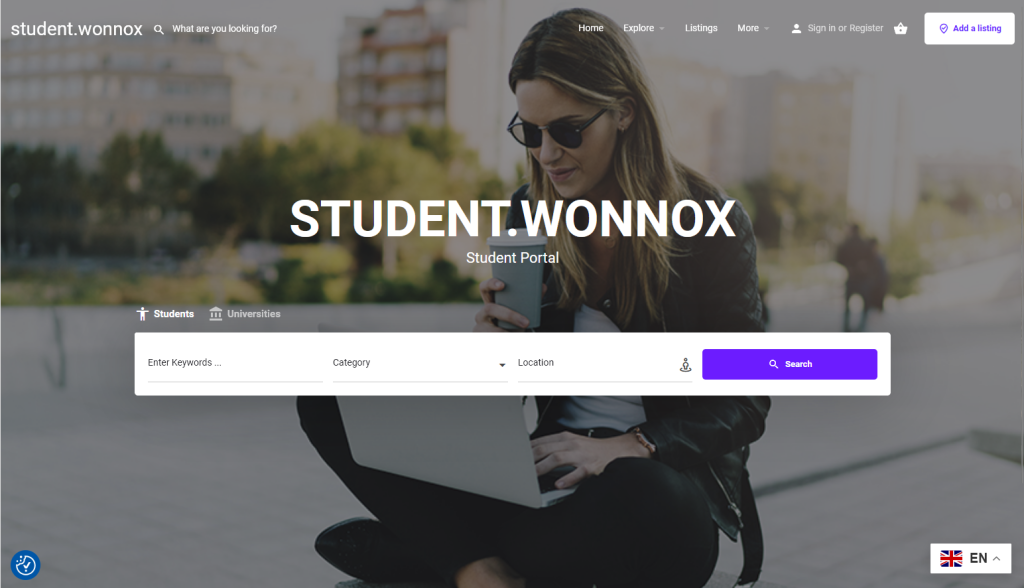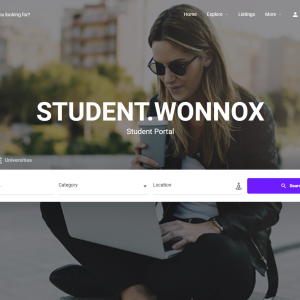
- Direct message
- Leave a review
- Bookmark
- Share
- Report
- prev
- next
Description
A university listing or profile in a web directory under the "student" category should effectively present key information that prospective students, parents, and educators need to assess and compare educational options. This listing aims to provide a comprehensive overview of what the university offers, including academic programs, facilities, and campus life, while also emphasizing unique features that make the institution stand out. Here are the essential features that should be included in a university listing or profile:
1. Basic University Information
University Name: Clearly display the full name of the university to ensure easy identification.
Location: Include the address, city, state, and country where the university is located. This is especially important for students considering location as a factor in their decision-making.
Campus Overview: Provide a brief overview of the university's campus, including whether it has multiple campuses or is a single-site institution.
Logo: Include the university's official logo to enhance brand recognition and credibility.
2. Contact Information
Admissions Office Contact: Provide phone numbers, email addresses, and possibly a live chat link for direct communication with the admissions office.
Website Link: A link to the university's official website allows prospective students to explore detailed information directly.
Social Media Links: Include links to social media profiles like Facebook, Twitter, LinkedIn, and Instagram, which can give prospective students a sense of the university's community and culture.
3. Academic Programs
Undergraduate Programs: List the available undergraduate degree programs, such as “Bachelor of Arts in Psychology,” “B.S. in Computer Science,” or “B.A. in Economics.”
Graduate Programs: Include details on master’s and doctoral programs, like “MBA in Business Administration” or “Ph.D. in Chemistry.”
Professional Certifications: If the university offers certifications or short-term courses, mention these as well.
Specialized Programs: Highlight unique programs or departments, such as “Marine Biology Program,” “Film Studies,” or “Robotics Research Lab,” that set the university apart.
4. Admission Requirements
Application Process: Provide a brief description of the application process, including links to online applications and deadlines.
Entrance Exams: Mention any standardized test requirements, such as SAT, ACT, GRE, or IELTS scores, and minimum score expectations.
Eligibility Criteria: Outline the basic eligibility criteria, such as minimum GPA or required coursework, which helps students assess their chances of admission.
Scholarships and Financial Aid: Highlight available scholarships, grants, and other financial aid options, including merit-based, need-based, or sports scholarships.
5. University Overview
About the University: A brief introduction (200-300 words) that shares the history, mission, and core values of the university.
Ranking and Accreditation: Mention the university’s ranking (if applicable) and accreditation status. This adds credibility and helps prospective students evaluate the quality of education offered.
Notable Achievements: Highlight any major achievements, such as award-winning faculty, research breakthroughs, or partnerships with industry leaders.
6. Student Life and Extracurricular Activities
Campus Life: Provide a description of what student life is like on campus, including clubs, events, and social opportunities.
Sports and Athletics: Mention the sports teams, intramural activities, and fitness facilities available to students.
Cultural and Art Programs: Include information about arts, music, drama, and other cultural activities that contribute to a vibrant campus life.
Community Involvement: Highlight opportunities for students to engage with the local community through volunteering or service-learning programs.
7. Facilities and Infrastructure
Academic Facilities: Describe key facilities such as libraries, laboratories, research centers, and computer labs.
Housing and Dormitories: Provide information on the availability of on-campus housing, including types of accommodations (e.g., single rooms, shared apartments) and amenities.
Dining Options: Mention the dining halls, cafes, and meal plans available for students.
Health and Wellness: Highlight resources such as on-campus health centers, counseling services, and recreational facilities.
8. Campus Tours and Open Days
Virtual Tour: Include a link or description of a virtual campus tour for prospective students who cannot visit in person.
Open Day Information: Mention upcoming open days or special events for prospective students, including how they can register for these events.
Student Ambassadors: Describe any opportunities for prospective students to connect with current students or alumni ambassadors for personalized insights.
9. Research and Innovation
Research Opportunities: Highlight the university’s focus on research and innovation, including opportunities for undergraduate and graduate research.
Notable Research Centers: Mention any specialized research centers, such as “Center for Renewable Energy Research” or “Institute for Social Innovation.”
Industry Partnerships: If applicable, include information on partnerships with industries that provide students with internships, research projects, or job placements.
10. International Students
International Student Services: Describe support services for international students, including visa assistance, orientation programs, and language support.
Study Abroad Programs: Highlight any exchange or study-abroad programs that allow students to experience education in different countries.
Language Requirements: Specify English language requirements, such as TOEFL or IELTS scores, for international students.
11. Career Services and Alumni Network
Career Support: Describe career counseling services, resume workshops, and job placement assistance offered by the university.
Internship Programs: Highlight opportunities for internships with companies and organizations, which can help students gain practical experience.
Alumni Network: Mention the strength and reach of the university’s alumni network, including any mentorship programs or networking events that connect current students with graduates.
12. Tuition and Fees
Cost Breakdown: Provide an overview of the cost of attendance, including tuition fees for undergraduate and graduate programs, as well as additional costs like accommodation and supplies.
Payment Plans: Mention if the university offers payment plans or installment options to make education more affordable.
Financial Aid Services: Include information about financial aid counseling services that help students understand their options.
13. Student Reviews and Testimonials
Student Feedback: Include testimonials from current or past students about their experiences, which can help prospective students get a better sense of the university’s environment.
Ratings: If the directory allows, display ratings (e.g., star ratings or satisfaction scores) given by students for various aspects like campus facilities, academic support, or social life.
Case Studies: Share brief success stories of students who have achieved notable accomplishments after graduating, such as starting successful businesses or pursuing advanced degrees.
14. Diversity and Inclusion
Diversity Initiatives: Mention the university’s commitment to diversity and inclusion, including student support groups, diversity scholarships, and cultural awareness programs.
Support for Minority Students: Describe resources like affinity groups, mentorship programs, or safe spaces for minority students.
15. Call to Action (CTA)
Encouraging CTA: Use clear calls to action, such as “Apply Now,” “Schedule a Campus Tour,” or “Request More Information.” These can help guide prospective students to take the next steps.
Newsletter Signup: Offer an option for prospective students to subscribe to a newsletter for updates about application deadlines, events, or campus news.
16. SEO Optimization
Keywords: Use relevant keywords throughout the profile, such as “top engineering university,” “affordable liberal arts college,” or “best university for international students.”
Meta Description: Write a concise meta description (150-160 characters) summarizing the university’s strengths, such as “Leading research university with strong STEM programs and a vibrant campus life.”
Tags: Use tags that align with the university’s strengths and programs, such as “MBA,” “medical school,” or “study abroad.”
Conclusion:
A university listing or profile in a web directory should present a balanced overview that covers academic offerings, student life, and practical information like admissions and costs. By including a mix of detailed descriptions, student testimonials, and visual elements like a virtual tour, the profile can effectively attract and inform prospective students. A well-organized listing makes it easier for students to see how the university aligns with their goals and needs, making it a crucial tool for attracting potential applicants.

Add a review